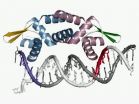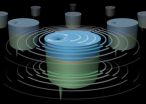(Press-News.org) NASA-NOAA's Suomi NPP passed over Tapah and captured a visible image of the storm that gave a hint of weakening as clouds began to fill its eye. On April 30 at 0900 UTC/5 a.m. EDT, Tropical Storm Tapah continued to weaken as wind shear began to increase and the storm moved toward cooler waters in the Northwestern Pacific Ocean.
NASA-NOAA's Suomi NPP satellite passed over Tropical Storm Tapah on April 30 and the VIIRS instrument aboard captured a visible image of the storm as it weakened from a typhoon to a tropical storm. The imagery showed that Tapah's eye was becoming cloud filled, but powerful thunderstorms circled the center of the storm.
Tapah's maximum sustained winds were near 55 knots/63.2 mph/101.9 kph as it moved to the north-northwest at 6 knots/6.9 mph/11.1 kph. Forecasters at the Joint Typhoon Warning Center expect Tapah to curve to the northeast as it moves around a ridge of high pressure later today and tomorrow (May 1). Tapah was centered near 19.4 north latitude and 147.1 east longitude, about 457 nautical miles southeast of Iwo To, Japan.
Tapah is expected to become extra-tropical within a day or two as it nears Iwo To.
INFORMATION:
Text credit: Rob Gutro
NASA's Goddard Space Flight Center
Suomi NPP satellite sees clouds filling Tropical Storm Tapah's eye
2014-04-30
ELSE PRESS RELEASES FROM THIS DATE:
New experimental vaccine produces immune response against MERS virus
2014-04-30
The University of Maryland School of Medicine (UM SOM) and Novavax, Inc. (NASDAQ: NVAX) today announced that an investigational vaccine candidate developed by Novavax against the recently emerged Middle East Respiratory Syndrome Coronavirus (MERS-CoV) blocked infection in laboratory studies. UM SOM and Novavax also reported that a vaccine candidate against Severe Acute Respiratory Syndrome Coronavirus (SARS-CoV) developed by Novavax on a similar platform also inhibited virus infection. Researchers reported these findings in an article published in the April 13, 2014 issue ...
Whey beneficially affects diabetes and cardiovascular disease risk factors in obese adults
2014-04-30
New evidence shores up findings that whey protein, which is found in milk and cheese, could have health benefits for people who are obese and do not yet have diabetes. The study, which appears in ACS' Journal of Proteome Research, examined how different protein sources affect metabolism.
Lars O. Dragsted, Kjeld Hermansen and colleagues point out that obesity continues to be a major public health problem worldwide. In the U.S. alone, about 35 percent of adults and about 17 percent of children are obese, a condition that can lead to a number of health issues, including ...
SDSC resources, expertise used in genomic analysis of 115 year-old woman
2014-04-30
A team of researchers investigating the genome of a healthy supercentenarian since 2011 has found many somatic mutations – permanent changes in cells other than reproductive ones – that arose during the woman's lifetime. Led by Erik Sistermans and Henne Holstege from the VU University Medical Center in Amsterdam, the team recently published its findings in the journal Genome Research as reported by GenomeWeb.
While previous studies have examined mutations that arise in certain disease conditions such as leukemia, Sistermans said that it was not well known how many mutations ...
N-glycan remodeling on glucagon receptor is an effector of nutrient-sensing by HBP
2014-04-30
TORONTO -- A possible therapeutic target for control of blood glucose in the treatment of type 2 diabetes and obesity has been identified by Dr. Anita Johswich and her colleagues. Their findings were published in Journal of Biological Chemistry, online April 17, 2014.
An imbalance in the competing action of insulin and glucagon is widely viewed as a critical factor in onset of type 2 diabetes, a relentlessly increasing health problem. A delicate balance between two hormones controls blood glucose levels day and night. After a meal, blood glucose rises, which stimulates ...
A protein key to the next green revolution sits for its portrait
2014-04-30
If you pull up a soybean or bean plant and shake off the dirt, you might see odd swellings or bumps, like rheumatic finger joints, on its roots. Inside the cool, soil-covered bumps are bacteria that are making nitrogen with the help of an enzyme, something chemical factories can do only with the help of a catalyst and at high temperature and pressure.
The bacteria, typically members of the genus Rhizobia, break the strong triple bond between the nitrogen molecules in the air and repackage the nitrogen atoms in chemical compounds the plant can use. In return, the plant ...
'Charismatic' organisms still dominating genomics research
2014-04-30
Decades after the genomics revolution, half of known eukaryote lineages still remain unstudied at the genomic level--with the field displaying a research bias against 'less popular', but potentially genetically rich, single-cell organisms.
This lack of microbial representation leaves a world of untapped genetic potential undiscovered, according to an exhaustive survey conducted by UBC researchers of on-going genomics projects. The survey results are published in the May issue of Trends in Ecology and Evolution.
"We're still mostly analyzing the same well-known eukaryotic ...
Deep origins to the behavior of Hawaiian volcanoes
2014-04-30
Kīlauea volcano, on the Big Island of Hawai'i, typically has effusive eruptions, wherein magma flows to create ropy pāhoehoe lava, for example. However, Kīlauea less frequently erupts more violently, showering scoria and blocks over much of the surface of the island. To explain the variability in Kīlauea's eruption styles, a team including Bruce Houghton, the Gordon Macdonald Professor of Volcanology in Geology and Geophysics at the University of Hawai'i at Mānoa (UHM) School of Ocean and Earth Science and Technology (SOEST) and colleagues from ...
New tool for Joint Lab to investigate the chemistry of nature
2014-04-30
This news release is available in German. HZB-scientist Emad Aziz, who leads the Joint lab between HZB and Freie Universität Berlin, has developed and installed a new tool to investigate ultrafast dynamics in solutions and at interfaces with the use of ultrashort Laser pulses. Liquid phases are a natural environment for many interesting processes in chemistry and biology, and short light pulses allow insights into electronic and structural dynamics of molecules and molecular complexes. In particular, photoelectron spectroscopy with extreme ultraviolet (XUV) radiation ...
Harnessing magnetic vortices for making nanoscale antennas
2014-04-30
UPTON, NY—Scientists at the U.S. Department of Energy's Brookhaven National Laboratory are seeking ways to synchronize the magnetic spins in nanoscale devices to build tiny yet more powerful signal-generating or receiving antennas and other electronics. Their latest work, published in Nature Communications, shows that stacked nanoscale magnetic vortices separated by an extremely thin layer of copper can be driven to operate in unison, potentially producing a powerful signal that could be put to work in a new generation of cell phones, computers, and other applications.
The ...
NOAA-led researchers discover ocean acidity is dissolving shells of tiny snails off West Coast
2014-04-30
A NOAA-led research team has found the first evidence that acidity of continental shelf waters off the West Coast is dissolving the shells of tiny free-swimming marine snails, called pteropods, which provide food for pink salmon, mackerel and herring, according to a new paper published in Proceedings of the Royal Society B.
Researchers estimate that the percentage of pteropods in this region with dissolving shells due to ocean acidification has doubled in the nearshore habitat since the pre-industrial era and is on track to triple by 2050 when coastal waters become 70 ...




